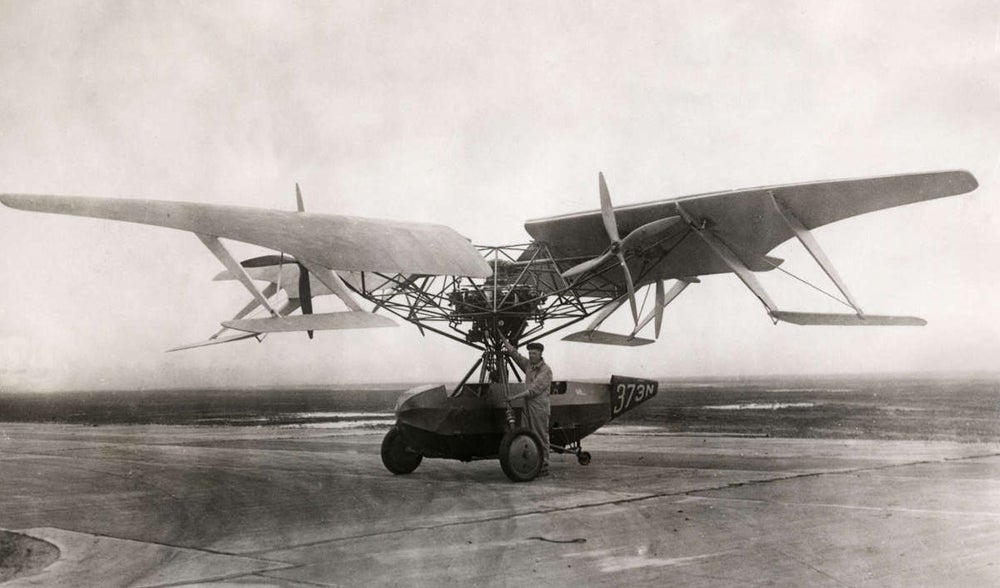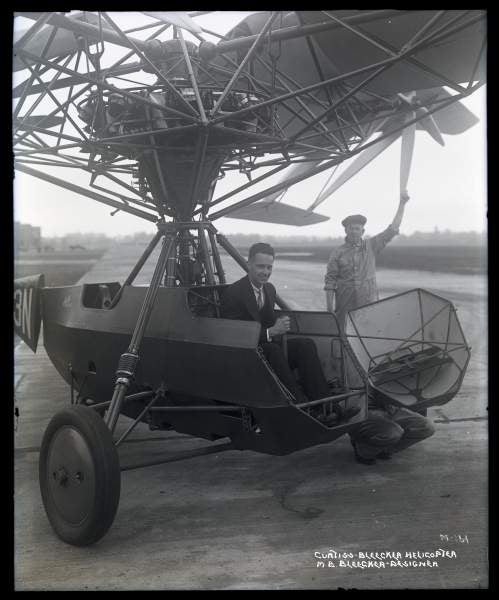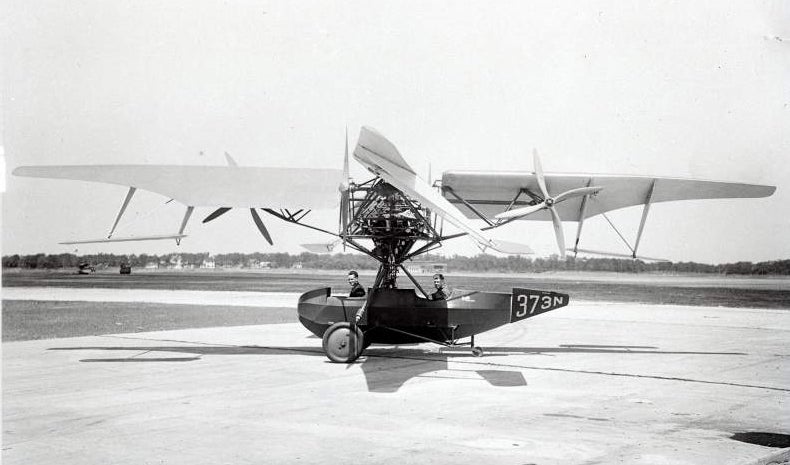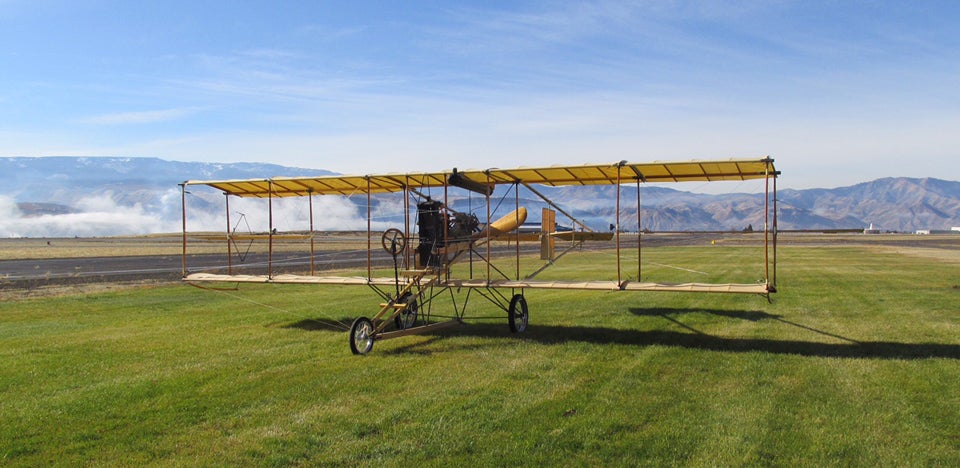 by "ttyymmnn" (ttyymmnn)
by "ttyymmnn" (ttyymmnn)
Published 01/24/2017 at 12:35
 by "ttyymmnn" (ttyymmnn)
by "ttyymmnn" (ttyymmnn)
Published 01/24/2017 at 12:35
Tags: wingspan
; planelopnik
; planes you've (probably) never heard of
STARS: 7
!!! UNKNOWN CONTENT TYPE !!!
From the
Planes You’ve (Probably) Never Heard Of Department
of
Wingspan
, we bring you the
Curtiss-Bleecker Helicopter.
!!! UNKNOWN CONTENT TYPE !!!

Once the first aircraft began to mimic the birds as best they could, starting first with gliders and then powered flight in 1903, flying was very much a horizontal process. But what if we could create an aircraft that could take off vertically, fly, then hover and land vertically in the same fashion? This was hardly a revolutionary idea. Chinese children have been playing with spinning, flying toys since 400 BC, and Leonardo da Vinci designed a helicopter in the 15th century. It wasn’t until 1939 that
Igor Sikorsky
produced the world’s first truly practical single-rotor helicopter. But the problem of vertical flight had captured the imagination of many other inventors before Sikorsky, and one of the more intriguing attempts at vertical flight was made by an American inventor whose name is every bit as ungainly as the contraption he devised.

Maitland Barkelew Bleecker was born on January 25, 1903 and, after graduating from the University of Michigan, he obtained a position with the National Committee for Aeronautics (NACA, the predecessor to NASA) at Langley, Virginia before leaving to work for the the Curtiss Aeroplane and Motor Company . His fascination with the problem of vertical flight led him to design his own helicopter, the Curtiss-Bleecker SX-5-1, which was built by Curtiss. But what set Bleecker’s helicopter apart from others was his unique, though rather complex, solution to getting the rotor blades to spin. Bleecker explained his solution in a 1930 interview in Modern Mechanics magazine:
My so-called Curtiss-Bleecker helicopter consists essentially of four large wings, or blades, mounted at right angles to one another and revolving in a horizontal plane. The wings are caused to revolve by propellers, one to each wing, mounted forward of the leading edge, about two-thirds of the way out.
The propellers are driven through a gear and shaft arrangement from one central engine, a 425-horse power air-cooled radial, mounted horizontally. To each of the wings are attached outrigger booms mounting small elevators or tail surfaces.
Thus, each unit is in reality a small airplane, consisting of a power-driven wing with a tail which can control the angle of incidence of the wing at any point. Beneath the four wings is slung a small fuselage. In this is located the crew. It is equipped with a conventional type of landing-gear.

One of the breakthroughs made by the Wright Brothers was their realization that a propeller is actually a spinning wing whose lift pulls or pushes an airplane through the air. Therefore, a helicopter is, in essence, an aircraft that has its propeller (rotor) on the top. The rotor lifts the helicopter, but designers still needed a way to change the pitch, or angle of attack , of all the blades together to allow the helicopter to go up and down. Ten years before Sikorsky developed the collective control to synchronize the pitch of each rotor blade, Bleecker’s helicopter used the trailing edge outrigger wing, called a “stabovator,” to adjust the pitch of the propeller blades in the same way the elevator of an aircraft affects the angle of attack of an airplane’s wing. After all, he characterized each propeller blade as a “small airplane.” Adjusting the pitch of all four rotors in the same fashion would cause the machine to take off, hover, or land vertically. But that’s the easy part.

Where it gets tricky is when you want to move forward, back or laterally. Through a rather ingenious system ( diagrammed by Popular Science Magazine in 1930), tilting the stick of the Bleecker helicopter side to side allowed for individual stabovators to move as they came into a desired position during their rotation. This is very similar to the solution devised by Sikorsky with the cyclic , which increased or decreased the pitch of individual blades and allowed the entire disk to tilt based on the greater or lesser lift of that portion of the disk. But what about torque? Modern helicopters use an anti-torque rotor to control yaw and keep the helicopter fuselage from spinning out of control under the disk. According a 1934 edition of Popular Flying Magazine , the torque of the motor was negated by having the entire Pratt and Whitney Wasp radial engine spin along with the rotor. Bleecker also developed a so-called “spin vane” attached to the tail of the small fuselage that would turn the aircraft under the influence of the downdraft from the rotors. You can see the spinning engine and spin vane in action in this short video.
!!! UNKNOWN CONTENT TYPE !!!
My job is done. I feel that I have given to aviation an engine of the air which will revolutionize the industry if properly nurtured. My helicopter will rise vertically, it will hover over a given spot, it will descend safely vertically, and move horizontally at a reasonable speed. It should be an invigorating spur to aeronautics.
Despite Bleecker’s claim that he had finally solved the problems of vertical flight, his helicopter failed to take the world by storm, though it was certainly an interesting attempt at a solution. However, his helicopter never managed to get into the air. The ungainly aircraft did manage a few short hops inside the hangar where it was constructed, but an oil leak put an end to those tests, and that was the extent of its flight history. Testing stopped in 1929 when a driveshaft broke, and the economic realities of the Great Depression limited funding for the project. Undaunted, Bleecker continued work on his helicopter, but he was never able to eliminate problems with vibrations, and the project was eventually abandoned in 1933. Unfortunately, his helicopter didn’t quite live up to his billing, though his belief that his work would inspire others was not unfounded. Perhaps that was his greatest success after all.
!!! UNKNOWN CONTENT TYPE !!!
!!! UNKNOWN CONTENT TYPE !!!
!!! UNKNOWN CONTENT TYPE !!!
!!! UNKNOWN CONTENT TYPE !!!
!!! UNKNOWN CONTENT TYPE !!!
!!! UNKNOWN CONTENT TYPE !!!
!!! UNKNOWN CONTENT TYPE !!!
If you enjoy these posts, please join in the conversation and let me know. If you missed an episode, you can find them all at Wingspan .
!!! UNKNOWN CONTENT TYPE !!!
 "Jcarr" (jcarr)
"Jcarr" (jcarr)
01/24/2017 at 12:45, STARS: 0
Speaking of Curtiss, you should read about the restoration of this 1909 Pusher that was at Oshkosh. EAA’s in house magazine, Sport Aviation , had a really great piece on it in a recent issue. I haven’t been able to find the full text online, though.

!!! UNKNOWN CONTENT TYPE !!!
 "ttyymmnn" (ttyymmnn)
"ttyymmnn" (ttyymmnn)
01/24/2017 at 12:51, STARS: 1
Thanks. Those guys must have had balls of brass to fly in those things. Of course they built it, so one would hope they had faith in their contraption.
 "LongbowMkII" (longbowmkii)
"LongbowMkII" (longbowmkii)
01/24/2017 at 15:31, STARS: 0
Oil leak, ya don’t say? I imagine the centrifugal force sent the oil through all the seals and gaskets in the heads and away from the crank.
I assume there were solutions attempted. I’m curious what they were.
 "ttyymmnn" (ttyymmnn)
"ttyymmnn" (ttyymmnn)
01/24/2017 at 15:45, STARS: 0
It’s actually pretty hard to find a whole lot of info on this contraption. The best stuff I found was from magazine articles around the 1930s. A rotating engine wan’t a new idea, though. The Sopwith Camel, along with other WWI fighters, had a radial engine that rotated with the propeller. Thing is, though, Bleecker’s engine, while no doubt more powerful than the rotary engines that came before, had an enormous amount of weight to turn, along with lots of complex linkages.
!!! UNKNOWN CONTENT TYPE !!!
https://en.wikipedia.org/wiki/Rotary_engine
 "LongbowMkII" (longbowmkii)
"LongbowMkII" (longbowmkii)
01/24/2017 at 16:11, STARS: 0
Huh, that’s like a two stroke in that it was a total loss oiling system. the oil was put into the hollow crankshaft, and allowed to go though the intakes and be burned off. I guess this horizontal layout would’ve been similar.
But that raises another question; Whether it was somehow pumped up through the crank or gravity fed and the oil tank spun with the engine.
Early aviation is cool.
 "ttyymmnn" (ttyymmnn)
"ttyymmnn" (ttyymmnn)
01/24/2017 at 16:16, STARS: 0
Questions I cannot answer. And yes, early aviation is very cool.
 "You can tell a Finn but you can't tell him much" (youcantellafinn)
"You can tell a Finn but you can't tell him much" (youcantellafinn)
01/24/2017 at 16:16, STARS: 0
The ungainly aircraft did manage a few short hops inside the hangar where it was constructed, but an oil leak put an end to those tests, and that was the extent of its flight history.
So it was a collection of parts loosely organized around an oil leak. Sounds like a helicopter to me.
I all seriousness that is an ingenious solution to powering and controlling a rotor. Interestingly enough the idea of propelling the rotor instead of powering the rotor survived into the jet age. https://en.wikipedia.org/wiki/Tip_jet
 "ttyymmnn" (ttyymmnn)
"ttyymmnn" (ttyymmnn)
01/24/2017 at 16:20, STARS: 0
So it was a collection of parts loosely organized around an oil leak. Sounds like a helicopter to me.
I think you mean “Volkswagen.”
Interestingly enough the idea of propelling the rotor instead of powering the rotor survived into the jet age.
With arguably similar results. I think it’s one of those ideas that technology finally caught up with, but simply turned out to be a less-than-stellar solution.
 "Cé hé sin" (michael-m-mouse)
"Cé hé sin" (michael-m-mouse)
01/24/2017 at 18:42, STARS: 0
“According a 1934 edition of Popular Flying Magazine , the torque of the motor was negated by having the entire Pratt and Whitney Wasp radial engine spin along with the rotor”
This couldn’t possibly have worked, surely? If this thing ever got into the air it was as likely to rotate the fuselage around the wing/rotor assembly as vice versa.
 "ttyymmnn" (ttyymmnn)
"ttyymmnn" (ttyymmnn)
01/24/2017 at 18:43, STARS: 0
That was my exact thought, but, since it never flew, we’ll never know. When I read that, I thought, “Bullshit; it’ll spin like a top.” But I’m no aerodynamicist.
 "Rock Bottom" (rockbottom81)
"Rock Bottom" (rockbottom81)
01/31/2017 at 13:27, STARS: 1
Maybe I can help!
The only torque applied to the fuselage in this arrangement is from mechanical drag in the bearing that bears the weight of the fuselage. Incidentally, that rotational load ends up being pretty low.
There’s a whole obscure branch of the rotorcraft family sometimes called “gyrodynes” that work like this. The British tried it several times (including for passenger service in the Fairey Rotodyne), and the US government has had a go at is a few times (the McDonnell XV-1 comes to mind). Most of these used a fuselage-based engine to blow air into the rotating frame and out through wing tip jets. They would then use some other fuselage based prop or jet for edgewise motion, instead of through differential lift from cyclic control. Cool machines, but I have been told they’re super loud.
https://en.wikipedia.org/wiki/McDonnell_XV-1
https://en.wikipedia.org/wiki/Fairey_FB-1_Gyrodyne
https://en.wikipedia.org/wiki/Fairey_Rotodyne
!!! UNKNOWN CONTENT TYPE !!!
 "ttyymmnn" (ttyymmnn)
"ttyymmnn" (ttyymmnn)
01/31/2017 at 14:08, STARS: 1
Thanks! That makes sense.